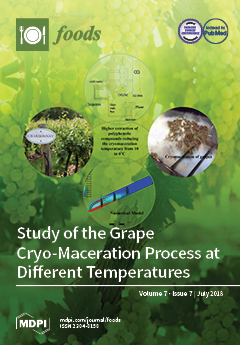During the processing of Irish Brown Crab (
Cancer pagurus), protein and moisture are released and losses up to 10% (by weight) are common. The objective of this study was to investigate the use of clean label ingredients to reduce this loss,
[...] Read more.
During the processing of Irish Brown Crab (
Cancer pagurus), protein and moisture are released and losses up to 10% (by weight) are common. The objective of this study was to investigate the use of clean label ingredients to reduce this loss, without adversely affecting shelf-life or promoting the growth of spoilage bacteria. Following preliminary studies, 5% (
w/v) sodium caseinate (SC) and (5%,
w/v) potato starch (PS), with and without (0.5%,
w/v) ascorbic acid (AA) were selected. Ninety crabs (30 per treatment) were soaked and boiled in water (control 1), AA (control 2), SC, PS, SC plus AA, or PS plus AA and analyzed for cook loss as well as pH, aw, water holding capacity (WHC), and microbial shelf-life (total viable count (TVC), total Enterobacteriaceae count (TEC), and spoilage bacteria) during 28 days storage at 4 °C. On average, 11.1% of the control 1 weight was lost during processing. This was reduced to 8.0% when treated with AA (control 2) and to 3.5%, 4.7%, 5.8%, and 2.3% with SC, PS, SC plus AA, and PS plus AA, respectively. None of these treatments negatively impacted on shelf-life and similar growth curves were observed for TVC, TEC,
Pseudomonas spp.,
Clostridium spp., lactic acid bacteria (LAB), and hydrogen disulphide producing bacteria, regardless of treatment. It was therefore concluded that, subject to sensory evaluation and validation under commercial conditions, these natural ingredients could be used to substantially increase the yield and hence commercial value of crab meat, without adversely affecting shelf-life.
Full article






